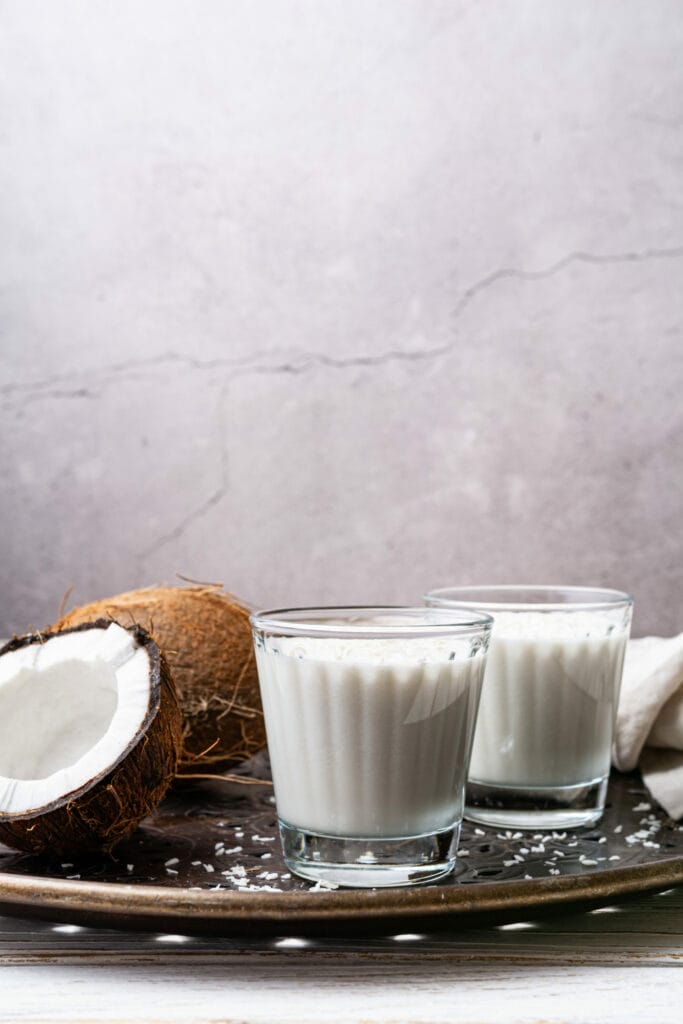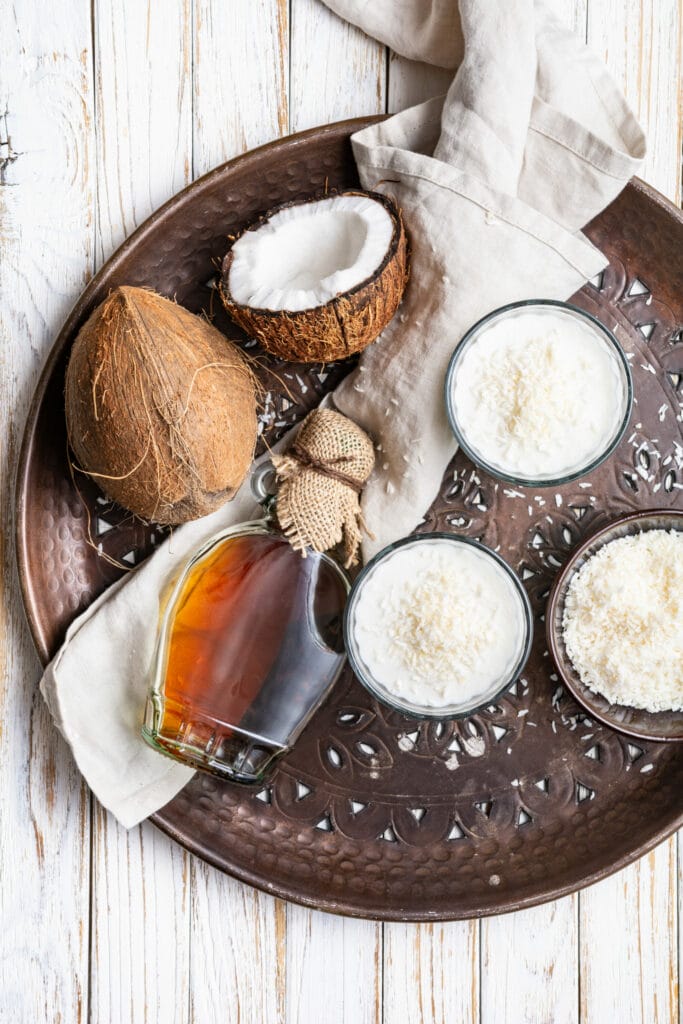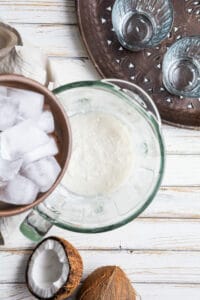For now, love yourself and enjoy this one ...
Now love yourself and enjoy this one ...
Go cuckoo for coconut with this Coconut-Milk Smoothie—a simple yet sweet Caribbean concoction that’s a dairy-free creamy dream.

Table of Contents
If I can’t be in the tropics, I at least like to convince my taste buds I am. One of the easiest ways to do that is to whip up one of these Coconut-Milk Smoothies. It has a short-but-very-sweet ingredients list (which isn’t something I usually associate with tropical cocktails) and what’s more, one of those ingredients is actual coconut!
I don’t get the opportunity to work with coconut very often. Usually, any coconut in my food and drink takes the form of cream of coconut or coconut milk. And, as much as I like both of those options, they’re merely derived from the fruit. With coconut chunks present, these smoothies’ texture is something altogether different. They’re creamier than creamy and heavenly heavy.
While this smoothie has its health benefits (see more on that below), I don’t drink this as a meal substitute or reinvigorating post-gym snack. Nope. This one is all about that taste and texture. A tropical treat.
Is This Coconut-Milk Smoothie Healthy?
Coconut milk contains lots of fat; some of it is good fat (MCTs), some of it is bad fat (saturated fats). So while I prefer to focus on the good, it’s important to be mindful of the bad and keep your consumption of these coconut treats in control. The maple syrup contains sugar, which, while natural, can still wreak havoc with a diet. As it stands, these three ingredients can be a part of vegetarian, vegan, paleo, and keto (use monk fruit or stevia instead of syrup) diets.
Can I Use a Whole Coconut and Do It Myself?
I like your “can do” attitude! While buying the coconut milk and chunks at the store is much more convenient, you’ll enjoy truly fresh ingredients if you do it yourself. I also don’t doubt the smoothie will be much more satisfying. Here’s what to do:
- Pick a heavy coconut. It should have no cracks and, when shaken, emit the sound of water swishing about.
- Locate the “eyes”, or three soft spots at one end of the coconut. Pierce two of the eyes with a knife or screwdriver and let the water leak out.
- Find the seam. It’s the weak point around the coconut. Strike it with a chef’s knife or cleaver all around.
- To separate the two halves, you may need a smaller knife. Once the coconut has been pried open, its meat is yours to extract. (That sounds gorier than intended!)
INGREDIENTS
- 2 cups coconut milk
- 2 tbsp maple syrup or preferred sweetener
- 1/2 cup coconut chunks (fresh or frozen)
- 1 cup ice

INSTRUCTIONS
Blend
Start by mixing the coconut milk with your choice of sweetener and coconut chunks until smooth.
Thicken
Add ice to the mixture and blend again to achieve the perfect creamy thickness.
Enjoy
Pour your freshly blended smoothie into glasses.
Devour!

FAQs & Tips
If you plan on drinking your leftovers in the next couple of hours, you can store it in the fridge in an airtight container (I usually just keep it in the blender pitcher). You can also freeze the smoothie. Pour it into ice cube trays or small containers then cover to make it easier to serve later. It should last for up to six months.
Depends on what you value more: flavor or convenience. Fresh coconut has a lovely, pronounced flavor that is lost slightly once frozen. Fresh coconut might also need cutting, which is an extra step you may not want to be bothered with. Frozen coconut is quick and easy to use. It also gives your drink that extra chill. I also find it thickens the smoothie more than the fresh stuff.
You can definitely use coconut water instead of or as well as the coconut milk. It really depends on the texture and density you like. Experiment to strike that perfect balance.
Now that would be one rich smoothie! Cream of coconut is creamier and sweeter than coconut milk so be aware of just how much you’re using. You may want to hold off on adding the syrup until you sample it without.
Fruits such as banana (frozen or fresh) and berries, or pineapple and mango for that tropical indulgence. For a protein boost add Greek yogurt (it will also keep it creamy), chia seeds (also a provider of fiber), and/or nut butter.

Other Recipes Featuring Coconut For You to Try
Coconut Apricot Energy Balls: Exotic fruits like apricots and dates join dried coconut flavored with ginger.
Coconut-Flour Banana Bread: A paleo-friendly recipe to serve as a snack or dessert alongside coffee or tea.
Coconut Granola: Rolled oats, coconut flakes, almonds, hazelnuts, and raisins form the base of this delicious breakfast bowl.

Coconut Milk Smoothie
Ingredients
- 2 cups coconut milk
- 2 tbsp maple syrup or preferred sweetener
- 1/2 cup coconut chunks fresh or frozen
- 1 cup ice
Instructions
- Combine coconut milk, sweetener, and coconut chunks in a high-speed blender. Blend until smooth.

- Add ice to the blender and continue blending until you reach your desired consistency.

- Pour the smoothie into glasses and serve immediately.

Nutrition
The post Coconut-Milk Smoothie appeared first on Food Faith Fitness.
References:
By: FoodfaithfitnessTitle: Coconut-Milk Smoothie
Sourced From: www.foodfaithfitness.com/coconut-milk-smoothie/
Published Date: Tue, 12 Mar 2024 14:50:11 +0000
Frequently Asked Questions
What spices assist in recovery?
The use of spices to aid in healing is an ancient practice dating back centuries. Many spices have been used for their medicinal properties, including ginger, cinnamon, cayenne pepper, turmeric, and garlic. Each of these spices has unique benefits that can help with various health issues.
Ginger is known for its anti-inflammatory and antioxidant effects and can help reduce inflammation in the body. It can also be used to soothe an upset stomach or relieve nausea.
Cinnamon has been found to have a wide range of medicinal properties, including antiseptic, antifungal, antimicrobial, and antioxidant agents. It is even believed to help regulate blood sugar levels, making it beneficial in helping prevent diabetes.
Cayenne pepper has been used for centuries as a natural pain reliever and anti-inflammatory agent. It is also thought to increase circulation and metabolism, which can help the body heal more quickly.
Turmeric is an herb that contains curcumin, a powerful antioxidant. Curcumin is beneficial in treating various conditions, from arthritis and neurological disorders to cancer.
Garlic is packed with nutrients and has many health benefits. It can help reduce inflammation, act as antibiotic, lower cholesterol levels, and even boost the immune system.
These spices are all-natural ways to help the body heal and improve overall health. They can all be easily incorporated into food or taken in supplement form for convenience. While spices alone won't cure any ailments, they can play an essential role in aiding healing.
In addition to spices, there are also other natural remedies for healing, such as herbs, essential oils, and homeopathy. Research has shown that many of these remedies can be effective in treating a variety of conditions. If you're looking for an alternative to conventional medicine, consider incorporating some of these natural remedies into your health routine.
Which plant can heal wounds?
Plants are amazing creatures. They grow, they live, and they die. They make food, clean our air and water, and help keep us healthy. But plants also do more than that...they heal wounds.
Plants release molecules called phytochemicals when they are injured. These chemicals act as antioxidants, which protect cell membranes from damage and promote healing.
Phytochemicals found in plants include flavones (found in citrus fruits), terpenoids (present in mint leaves), and polyphenols (common in berries).
In addition to these protective compounds, plants contain proteins, vitamins, minerals, amino acids, fatty acids, and carbohydrates that support the body's natural processes of healing.
The best way to use plants to heal wounds is to consume them directly. However, there are ways to apply the power of plants to treat wounds without eating them.
First, soak a cotton ball in an extract from the St John's Wort herb. This product contains salicylic acid, which helps reduce inflammation.
Next, place the soaked cotton ball on the wound. Avoid applying the herb directly to open cuts, burns, or puncture wounds. If you feel any burning sensation, remove the herb immediately.
You may also find that placing a few drops of essential oil on the affected area promotes faster healing. Lavender essential oil reduces swelling and speed recovery; rosemary stimulates blood flow and increases circulation; peppermint relieves headaches and muscle aches.
If you want to try your hand at growing some of your medicinal herbs, here are some tips:
- Start with small pots, so you don't end up with too much of one particular type of plant.
- Grow several different types of herbs together. The same goes for flowers and vegetables. Mixing it up will ensure you get all the benefits of each plant.
- Use organic fertilizer if you're growing your herbs indoors. Non-organic fertilizers may be harmful to your health.
- Harvest regularly. You'll enjoy the freshness of homegrown herbs, but leave enough time between harvests to allow the soil to replenish itself.
- Be careful not to overwater your plants. Overly wet soil encourages mold growth, which isn't suitable for your herbs.
- Wash your hands after handling your herbs. You don't want to risk spreading bacteria onto your plants!
What are healing flowers?
Healing flowers are plants that promote peace and tranquillity. They help us unwind after a stressful day and make us feel more relaxed.
They also help us connect to our inner selves and reconnect with nature.
These beautiful blooms are used for meditation, prayer, and contemplation.
We call hundreds of varieties of flowering plants ‘healing’ because they provide such a fantastic experience.
This list includes roses, lilies, irises, daffodils, peonies, tulips, hyacinths, and many more.
But there are two species that I find particularly special. These are the Geranium and Lilium.
Geraniums are very easy to grow and come in various colors. Liliums are also known as lily-of-the-valley, which means 'lily' and 'valley.' Both of these species are popular garden flowers.
Healing flowers are often found growing near water. They are said to bring peace and calmness to those who meditate with them.
In ancient times, people would light candles in flower petals to symbolize the sun. This way, they could honor the sun without needing to go outdoors.
Some say that when you look at these flowers, you may see angels dancing.
Is basil good for kidneys?
The answer is yes. Basil is an excellent food for kidney health. It contains potassium which helps reduce high blood pressure. It also contains vitamin K, which is essential for bone strength. As well as this, it is rich in antioxidants which help protect against heart disease.
Basil is great for digestion too. It contains digestive enzymes that break down protein and carbohydrates. This makes it easier to absorb nutrients from your meals.
Basil is a wonderful addition to any diet. Try sprinkling some over pasta dishes, salads, soups, and sandwiches. Or add little stir-fried vegetables, chicken, fish, meat, and tofu.
It's delicious in pesto sauce and fresh in salad dressings. You'll find many recipes online where you can learn how to cook with basil.
Try making basil oil by adding a few drops of pure olive oil to a jar filled with chopped basil leaves. Let it steep overnight, and then strain out the leaves. Use the oil as a massage oil or rub it onto your skin.
It will leave your skin soft and smooth.
Should You Use Herbs and Spices for Brain Health?
Herbs and spices have been used for centuries to improve brain health. Research shows that these natural remedies may help prevent dementia and Alzheimer's. Some herbs may even boost memory.
However, no scientific evidence proves that eating an herb-rich diet can keep your mind sharp. When it comes to improving cognitive function, there are more effective ways to do it.
One study found that older adults who took 1000 mg of vitamin B6 daily had fewer mental lapses than those taking placebo pills. Another study showed that drinking coffee could increase blood flow to the brain. Other studies suggest that exercise, socialization, and sleep improve brain health.
The bottom line is that herbs and spices probably won't make much difference to your overall health. But they might give you extra energy and focus, which can come in handy during the day.
What plant helps with infection?
There are plants out there that help fight infections. Some even contain anti-bacterial properties. One of them is mint.
Mint has been used for centuries to treat respiratory infections such as cold symptoms and flu. Mint also supports digestion and relieves gas pains. You may find relief with peppermint tea if you have an upset stomach. Peppermint oil has antibacterial properties, which make it effective against germs.
Peppermint tea contains menthol, beta-carotene, vitamin C, calcium, magnesium, iron, and potassium. These nutrients support healthy immune systems and provide energy to keep your body strong.
You can make peppermint tea at home by adding one teaspoon of dried mint leaves to boiling water. Let steep for five minutes and drink hot three times per day.
Or you can buy peppermint tea bags at any grocery store. Simply add two teaspoons of dried mint leaves to a cup of hot water. Steep for 10 minutes and strain. Drink hot three times per day for best results.
Statistics
- Studies have shown that cinnamon can lower fasting blood sugars by 10-29% in diabetic patients, which is a significant amount (9Trusted Source10Trusted (healthline.com)
- For those with high cholesterol, garlic supplementation appears to reduce total and/or LDL cholesterol by about 10-15% (72Trusted Source73Trusted (healthline.com)
External Links
[TAG33]
- Antioxidant capacity of 26 spice extracts and characterization of their phenolic constituents - PubMed
- Cinnamon: A Multifaceted Medicinal Plant - PMC
[TAG36]
[TAG39]
- Ashwagandha | Memorial Sloan Kettering Cancer Center
- Grape Seed | Memorial Sloan Kettering Cancer Center
[TAG42]
How To
How to Use Herbs and Spices in Cooking?
Herbs and spices are a great way to add flavor without adding calories. If you've been cooking for years, you already know how easy it is to make even bland foods taste delicious. Try these tips to add more flair to your dishes.
Herbs and spices are essential ingredients in any kitchen. In addition to making food taste better, they also help keep food fresh longer. From enhancing the flavors of soups and sauces to infusing drinks with exotic tastes, herbs and spices go far beyond traditional cooking.
The most important thing to remember when using herbs and spices is to use them sparingly. Even though they may seem like powerful ingredients, they have a strong scent. So, sprinkle them on top instead of piling them onto a dish.
You'll find that the best herbs and spices come in small containers. This makes them easier to measure out, so there won't be any waste. Plus, you'll save money because you won't have to buy large amounts.
Another tip is to avoid placing herbs and spices directly on hot pans. Heat will quickly dry out the herbs and spices, leaving a bitter aftertaste. Instead, place them on paper towels to absorb excess moisture.
Use herbs and spices liberally in recipes where they naturally complement each other. For example, cinnamon pairs well with apples, while garlic complements tomatoes. Once you learn how to combine flavors, you'll be able to create your signature dishes.
Try experimenting with different herbs and spices to spice up meals. For instance, mix thyme, rosemary, oregano, and basil in a bowl. Add salt and pepper to taste. Then toss the mixture with pasta, chicken, or fish.
After the meal, store leftover herbs and spices in airtight jars. This will prevent them from drying out. Also, wrap unused herbs and spices tightly in plastic wrap. They should stay fresh for at least three months.
If you're looking for ways to improve your diet, consider trying new herbs and spices. You can experiment with different blends until you discover your favorite combination. The possibilities are endless!
 |
[TAG44]This Irish kale colcannon recipe is perfectly buttery and fluffy and easy to make with a handful of basic ingredients. St. Patrick’s Day is just around the |
 |
[TAG45]Hello hello! Just wanted to pop in with a cute little life update. ♡ I’m delighted to share that our sweet son, Milo Alexander Martin, came to join our family |
 |
[TAG46]Easy to make full flavoured recipes. Life is too short for boring food! |
 |
[TAG47]This vibrant lemony broccoli pesto pasta is quick and easy to make and full of fresh flavors. Your veggies, greens, and pasta…all in one gorgeous dish! ♡ We’re |
 |
[TAG48]This simple roasted carrot soup recipe is made with creamy tahini and topped with crispy za’atar chickpeas. Naturally gluten-free, vegetarian and vegan. If you |
 |
[TAG49]HEALTHY & KID-FRIENDLY MEALS easy dinner recipes made in minutes. The Latest Recipes st. Patrick's Day Recipes Hello! I'm Sara! Welcome to Dinner at the Zoo! |
 |
[TAG50]My longtime favorite flourless cake recipe is decadently rich and delicious, naturally gluten-free, and easy to make in under 1 hour! Trust me, this flourless |
 |
[TAG51]This vegetarian cabbage roll soup is filled with protein-rich lentils and all of the delicious flavors you love from traditional cabbage rolls. Naturally |
 |
[TAG52]From comfort foods to indulgent dishes browse hundreds of recipes that your family will love and make over and over again. Cooking Classy has never been easier, |
 |
[TAG53]These zesty roasted sweet potato and chickpea bowls are layered with sautéed spinach and brown rice and tossed with my favorite 4-ingredient chipotle tahini |
 |
[TAG54]This classic matcha latte recipe is easy to make and customize to your liking and always so delicious. The older I get, the more I’m convinced that one of |
 |
[TAG55]A family food blog with hundreds of simple, tested and approved recipes. Find easy step-by-step photo cooking instructions and video recipes. |
 |
[TAG56]This veggie-loaded broccoli cheese soup recipe is perfectly velvety and creamy without using heavy cream. Instant Pot, Crock-Pot and stovetop options all |
 |
[TAG57]This winter farro salad recipe is made with the most delicious blend of seasonal fruit, greens, nuts, crumbled cheese and tossed with a vibrant orange ginger |
 |
[TAG58]find out hundres of delicous food recipes |
 |
[TAG59]This lovely white wine sautéed mushrooms recipe is quick and easy to make, full of rich savory flavors, and can pair well as a side dish with many different |
 |
[TAG60]This traditional Swedish meatballs recipe is bursting with rich, savory flavors and topped with a creamy gravy. Always so comforting served over mashed |
 |
[TAG61]The food blog with mostly healthy recipes made with real, whole foods inspiring more people to get into the kitchen and cook something good. |
 |
[TAG62]This classic Irish coffee recipe is easy to make with 4 ingredients in just a few minutes. Always so warm and cozy! Let’s warm up with a hot mug of Irish |
 |
[TAG63]This snickerdoodle blondies recipe is irresistibly rich, buttery, tangy, and sprinkled with a crunchy cinnamon-sugar topping. Yes, they’re just as good as you |
 |
[TAG64]A food blog with hundreds of quick and easy dinner recipes. Classics done right, incredible one pot recipes, Asian takeout at home and holiday feasting! |
.png)





